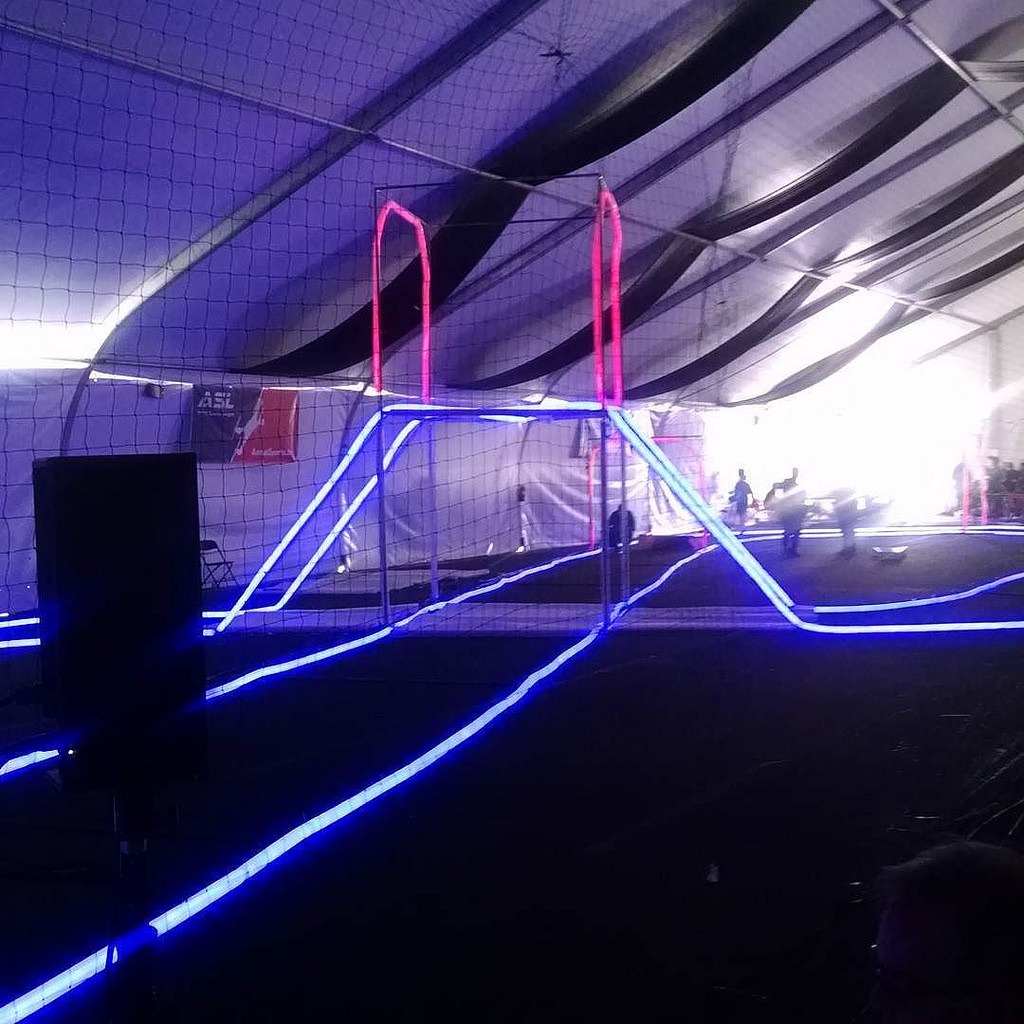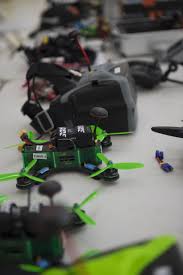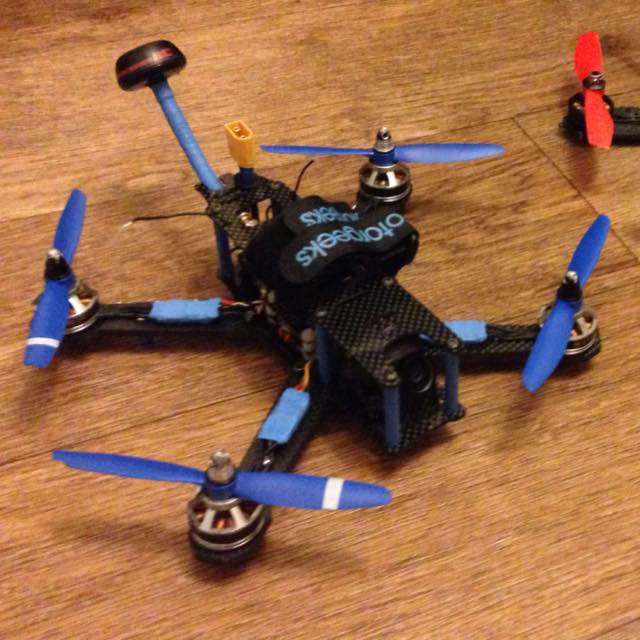So you want to be part of drone racing and wondering how to start? Here’s a guide to help you get started with an exciting hobby that can be extremely daunting, yet also a rewarding learning experience.
Get a cheap toy drone to learn on.
Before you can go around racing with a flying toy, it’s best to gain experience and understanding first in flying a cheap drone, especially if you aren’t a master of the basics yet. If you’re a gamer, you’ve got an edge. Your experience in sitting in front of the PlayStation or Xbox may come in handy, as piloting a drone needs many of the same motor skills that gaming also develops. Also, flying FPV feels like a video game, except that it’s real, there’s no reset or pause button, and you can damage your drone in a crash or through losing control.
With that being said, you really need to practice. The first time you fly a quadcopter, you’re most probably going to crash, so it’s best to buy a cheaper one first before venturing into a more expensive, hobby-grade drones. Toy-grade drones cost around $20 to $60, depending on the size and features. Common toy quadcopter brands perfect for beginners include Hubsan, Syma, Blade, Parrot, UDI, Cheerson, Eachine, Neewer, Estes and more.
Along with the quadcopter, get some extra batteries and propellers. A typical toy-grade battery will only last for 5-6 minutes, so be prepared with at least 5-6 batteries extra so you can get a good 30 minutes of flying every time you go out. Also, prepare extra propellers, as they won’t fly well when bent or chipped.
Starting with a cheap toy one is also a smart choice so you can gauge if you’re really into drone racing or not. If you fell in love with flying a toy drone, then most probably you’d like to try flying more advanced equipment. If for some reason you found that drone racing or simply flying isn’t a hobby for you, then you’ve only spent less.
Besides learning how to fly a drone, another important lesson is to be responsible. Drones have enough negative image already, so it’s up to the pilots to do whatever they can to fly safely and responsibly. First of all, avoid flying a drone in an area where there’s many people, houses, trees or other obstruction that might be damaged, frightened or hurt. Don’t use it to prank your friends as it may go wrong. Respect other people’s privacy and don’t fly your drone to “spy” on them. You can fly it in open fields or in a park, but when people start coming to do their stuff, find somewhere else to fly. Other people may not like the sight of your drone flying above and around them, as they may think they are being photographed even if your drone doesn’t even have a camera, and they can also fear that a dangerous toy may come crashing into them.
Save up money.
Like most outdoor hobbies, drone racing requires you to spend and invest in equipment and gear. Let us let you know upright that drones can be expensive. Prepare your wallet for lots or consumable components in this hobby. You will break propellers while learning, so invest in a couple more extra. You can break pieces and parts of your quadcopter during a crash, and you can burn out electrical components. You’ll need extra batteries and perhaps even chargers for more decent and easier flying sessions. You’ll need FPV goggles and spare motors. You’ll also need tools to repair your drone, as you may not have some of them.
If you don’t have too much cash to spare and you want to get started as a hobbyist, then you’ll need to save at least $800 to $1000. It’s so hard to wait for a long time to be able to afford some parts you need to fly again after crashing your drone, so make sure you have money and you already bought extra parts in case accidents happen.
With drones, you get what you pay for. If you’re only willing to spend the bare minimum, then you may not be able to keep up with the speed, agility, and durability of the drones of other players. A fully-functioning, high-quality drone racing set-up could cost at least $1000. This is why it is recommended to practice on cheaper drones before piloting more expensive aircraft.
Get to know racing drones.
Drone racing uses quadcopters with an FPV (First-Person View). Before anything else, you must understand what FPV is. It means that a drone has a video camera mounted on the drone to transmit the live video to the pilot via a display screen or FPV goggles, so the pilot is flying the drone as if he/she is onboard it. In short, FPV allows you to view the world as the drone “sees” it. This style of flying is marked in contrast to third-person-view where the pilot keeps on a watch on the drone from the ground while flying it.
Racing drones can either be built from parts, built from a kit, or pre-built ARF/RTF (we’ll discuss what it means later on), but all of them consist mostly of these parts:
- Frame/body
- 4 motors
- 4 propellers
- 4 ESCs (Electronic Speed Controller)
- Flight controller
- Radio transmitter (Tx) and receiver (Rx)
- Video transmitter (vTx) and receiver (vRx)
- Lithium-polymer (LiPo) battery
- Antenna
- Onboard camera for FPV
- Monitor/display screen or FPV goggles
- Battery straps
- HD camera for recording (optional)
1. Built from parts
Building your own drone up from parts you’ve individually selected is the best way to customize and be unique. You can ensure that you get the exact drone specs you want. Plus, nothing looks more awesome and admirable than a well-built quadcopter you made on your own. If you’ve gotten passionate about drones, you’d love building from parts as you can tinker and research each component. Not only would you end up with a drone made of the parts you hand-picked, but you can also be familiar with the internal components of the drone, making it easier for you to repair in the future in case you crash or break something.
Since it’s the slowest method for getting in the air (obviously), getting a racing drone built from parts is recommendable for those who don’t mind investing time for the hobby. This is also for those who have a passion for building things since this needs a lot of patience and knowledge about a bit of engineering. It’s also preferable for experienced drone racers who already developed preferences over certain parts. Also, you need to keep track of the multiple receipts/proofs of purchase from different vendors and deal with different warranty/return policies.
2. Built from a kit
Building from a kit is like building from parts, except that all or several parts come from a single vendor. This is the cheapest way to get your own racing quadcopter. Dealing with usually, one vendor reduces the cost as compared to buying parts by themselves. Also, you’d only have to contact one seller and you’d only wait for one shipment only. More importantly, you can be sure that the pieces all fit and work together, as they come in a kit. It’s great for those who want to experience building their drone from the ground up.
But before you buy a drone kit, check out reviews, social media comments and forums for other people’s experience with a specific kit before you buy. Sometimes, sub-par parts can come within a seemingly good pack. It’s best to pick a kit that has been tried and tested by a lot of satisfied drone pilots.
3. Pre-built drones
Getting pre-built quadcopters are the easiest way to get into drone racing. These are generally more expensive than those built from parts or from a kit. Pre-built drones are preferable for those who primarily want to just fly. Since these are assembled in a factory, tested by experts and packaged up, you can rest assured that the drone will fly great. Pre-built drones come in ARF or RTF kits:
- ARF (Almost-Ready-to-Fly) – These are quadcopters that typically do not include a transmitter, a radio control receiver, batteries, and FPV goggles. You have to bind these items yourself into the drone because these can be easily transferred and installed in and out from other quadcopters, lessens the cost of buying them over and over again. After that, you can easily go and fly your drone.
- RTF (Ready-to-Fly) – These are quadcopters are obviously, completely ready-to-fly. They come in a package complete with batteries, controller, charger, and sometimes even FPV goggles. Usually, the only construction needed with this type is mounting the propellers to the motors. You can get it in the air after that, and (supposedly) after charging the batteries. You can also get better community support, as a lot of other drone pilots are using the same or are familiar with the same parts as your drone’s. However, it’s the most expensive option.
By the way, expect that you will crash your drone eventually, and you’ll need to replace parts and repair it. It’s really part of the drone racing hobby. You need to know how to solder and get a good soldering iron – most especially if you’re getting a to-build drone kit or parts.
Know what to look for in a racing drone.
Now that you know the types or racing drones, here are the main factors you must consider in choosing your one.
1. Speed
Since you are going to fly it on a race, speed is one of the most important factors. It must be fast enough to compete with other drone pilots in your class.
2. Maneuverability
The maneuverability of a drone is equally important as its speed. It must be responsive and easy to control, especially in gated races where a drone has to do acrobatic turns at a high speed. The maneuverability of a drone depends on the flight stability of the controller and the flight control software; the lifting power of the motors, propellers, and ESCs; the control response time of the flight controller; and the smooth banking of the flight control software.
3. Durability
Once you’ve got a drone, get your heart, mind, and budget set with the fact that you’re going to crash it one way or another (like we mentioned earlier) – especially if you get involved with drone racing. A drone can be rendered completely useless, or it may just break some propellers or a part of the frame, so it must be durable overall. Generally, the lighter the aircraft, the more durable and less prone to damage it can be, and that’s why smaller drones are recommended for beginner pilots.
Find a drone racing group.
You might be interested in drone racing since you have been invited to watch a drone race event by a friend, or you simply happen to know someone into drone racing and it fascinated you. If that’s the case, you can join and dive right into that person’s group. A racing group has regular meetings where members can get together and fly their drones, and they also hold local events. It’s best to find one that is nearest you.
But if you’ve got interested without another person’s influence, you can start by finding drone racer groups online. Active online support groups are a great place to meet others and discuss anything about drone racing. You may join them if they do meet-ups and racing events.
Organizations like the MultiGP, US Drone Racing Association and the Academy of Model Aeronautics (AMA) have local groups that bring together members for meetings, and those who are interested about drone racing are welcome to attend. Some organizations offer drone flying classes for beginners. A club may charge a membership fee as a support to their work.
Attend a racing event.
You might be thrilled about building or getting your own racing drone and being able to fly it… But nothing is more thrilling than entering a race. The speed, the sounds, the action, the crashes – it all adds up to that thrill and excitement. You may come as an audience at first, or participate already if you feel ready.
A drone racing event can be held on indoor or outdoor tracks – some as simple as a track laid out in a local park or some as challenging as subterranean mines and abandoned buildings. The aim of a drone race is to finish the most laps in a given time. A usual course is around 100 to 210 yards long, with some sharp turns and altitude changes to test pilots’ control and maneuvering. A race course also usually has loops and hoops that drones have to fly through. If a drone misses a loop, it has to fly back and try to go through it.
Races are organized into classes for different drone specifications, specifically size and weight. The names of classes vary depending on the organization or club. For most racing events, there is an open class where anything goes, allowing all drone types to compete against each other.
An organized race needs advanced registration and a clear set of rules. Some events are made for members only, while other events may be open to anyone. Before the race, equipment will be checked to make sure it is properly set up, and there will be a safety briefing for the racers. Organizers will also provide a list of channels and you’ll be assigned a frequency so you won’t interfere with other racers.


